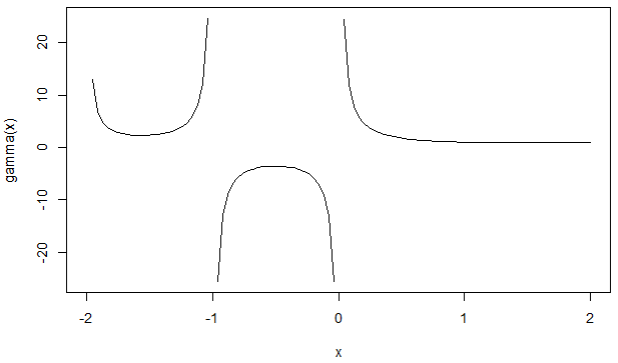Basic skills in R: Working with functions
 Combinatorial functions
Combinatorial functions
Gamma function and factorial The gamma function \(\Gamma(x)\) is defined for all real \(x\) except zero and negative integers by \[\Gamma(x)=\int_0^{\infty}t^{x-1}e^{-t}\,\dd t\] The factorial function is defined by \[x!=\Gamma(x+1)\] For a natural number \(n\) we have \[n! = 1\times 2 \times\cdots\times (n-1)\times n\] In R, we can use the functions gamma() and factorial() to compute values of the gamma function and the factorial function, respectively.
> factorial(4) [1] 24 > gamma(5) [1] 24 > gamma(1/2) - sqrt(pi) # in exact arithmetic equal to 0 [1] 2.220446e-16
> curve(gamma, -2,2)
Warning message:
In gamma(x) : NaNs produced

Binomial coefficient For natural numbers \(n\) and \(0\le k\le n\), the binomial coefficient \(\binom{n}{k}\) is defined as \[\binom{n}{k}= \frac{n!}{k!\times(n-k)!}\] For example, \[\binom{5}{2}= \frac{5!}{2!\cdot 3!} =10 \] In R, the function choose() can be used for computing a binomial coefficient.
> choose(5,2)
[1] 10
Combinations and permutations When we have \(n\) distinct objects, then we can order them in a sequence in \(n!\) ways. Each ordering is called a permutation of the object. In R, you can randomly generate a permutation with the function sample().
> set.seed(123) > sample(3) # a random permuation of 1, 2, 3 [1] 3 1 2 > sample(3) # a random permuation of 1, 2, 3 [1] 2 1 3 > sample(3) # a random permuation of 1, 2, 3 [1] 2 3 1
> sample(c("a", "b", "c")) # a random permutation of "a", "b", "c" [1] "a" "b" "c" > sample(c("a", "b", "c")) # a random permutation of "a", "b", "c" [1] "b" "a" "c" > sample(c("a", "b", "c")) # a random permutation of "a", "b", "c" [1] "c" "b" "a"
In \(\binom{n}{k}\) ways you can select \(k\) objects from a set of \(n\) distinct objects, without taking concern of the order in which you selected objects. Fine, but can you generate in R such \(\boldsymbol{k}\)-combinations from a set of \(n\) distinct objects? The answer is yes, namely via the package combinat. The session below shows examples.
> install.packages("combinat") > library(combinat) > permn(1:3) # generate all 6 permutations of 1, 2, 3 [[1]] [1] 1 2 3 [[2]] [1] 1 3 2 [[3]] [1] 3 1 2 [[4]] [1] 3 2 1 [[5]] [1] 2 3 1 [[6]] [1] 2 1 3 > permn(c("a","b")) # generate all permutations of "a", "b" [[1]] [1] "a" "b" [[2]] [1] "b" "a"
> combn(1:3,1) # selections of 1 number from {1, 2, 3} [,1] [,2] [,3] [1,] 1 2 3 > combn(1:3,2) # selections of 2 numbers from {1, 2, 3} [,1] [,2] [,3] [1,] 1 1 2 [2,] 2 3 3 > combn(1:3,3) # selection of 3 numbers from {1, 2, 3} [1] 1 2 3 > combn(letters[1:4], 2) # selections of 2 letters from {"a", "b", "c", "d"} [,1] [,2] [,3] [,4] [,5] [,6] [1,] "a" "a" "a" "b" "b" "c" [2,] "b" "c" "d" "c" "d" "d"
> combn(letters[1:4], 2, simplify = FALSE) # idem [[1]] [1] "a" "b" [[2]] [1] "a" "c" [[3]] [1] "a" "d" [[4]] [1] "b" "c" [[5]] [1] "b" "d" [[6]] [1] "c" "d"
Alternatively you could have used the package gtools. This package is more flexible as it allows to calculate the permutations and combinations both without and with repetition.


